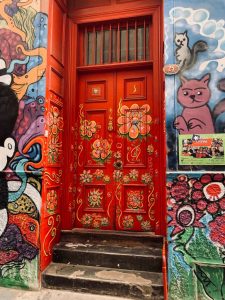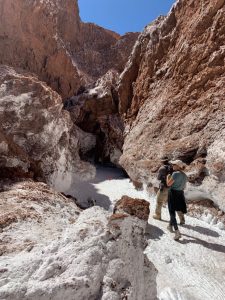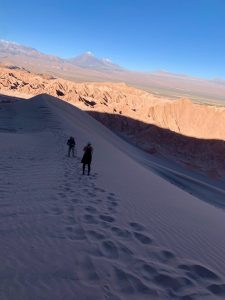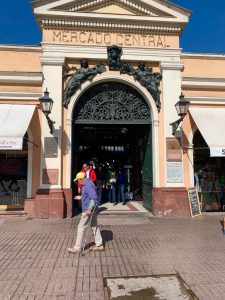K and I have lived in or traveled to a shitload of countries. (I should buy a map and put pins in it.)
In terms of cost and benefit, there are only three ways to travel: Budget Immersion Style, Group Discount Style, and Andrew Harper Style. And I’ve done them all.
Budget Immersion Style: You are short on cash but big in spirit. You take the cheapest flight regardless of where it’s going because you know that every destination has equal potential.
You sleep on lumpy mattresses, eat food you’ve never tasted before, travel in buses with people holding chickens on their laps, drink the local whatever (because they are so insistent), and make a serious effort to speak the language.
Traveling this way allows you to understand, first hand, what is unique and wonderful about the local culture. (Like it or not, your budget requires you to be immersed in it.) The big payoff is the respect you develop for the way other people live.
Group Discount Style: You fly economy to all the usual cities, stay at hotels catering almost strictly to Americans, eat astonishingly bad American-esque cuisine, visit the tourist traps in herds, speak only English, and make friends only with other English speakers you don’t ever want to see again. Other than being able to say, “I’ve been to _________,” there is no personal gain.
Andrew Harper Style: You fly first-class, stay at charming (and first-class) inns and B&Bs that none of your friends have ever heard of. Every meal you eat is the best meal you’ve ever had. And you can do whatever you want to do because your guide is working as if he’s expecting a $500 tip. (And by the end of the trip, you’re happy to give it to him.)
(By the way, if you’re not familiar with Andrew Harper, you might want to get acquainted. He’s been writing a newsletter about travel for as long as I can remember. He’s curated many of our trips. And though very expensive, they’ve all been memorable.)
I spent the 1970s traveling Budget Immersion Style, and it was great. Back then, every country had its own character and customs that were distinctly foreign. Everything felt wonderfully alien – from the way people dressed to the cars they drove to the street signs to the way light switches worked to the shape and functionality of toilets. And, of course, no one except tour guides “spoke” English.
K and I spent our early married years traveling Group Discount Style, and it was terrible. But now, in my semi-retirement years, we’ve discovered travel Andrew Harper Style… and it’s pretty darn addicting.
My general rule for touring foreign cities (our favorite spots to visit are parks, museums, galleries, churches, cemeteries, and monuments) is to leave a site the moment you are bored. Resist the urge to see everything or even the “most important” things. You are going to forget 95% of what you learn anyway, so look at less but enjoy more.
K and I figured this out many years ago. For us, four days seems to be just enough to feel like we got to know a city without overstepping its welcome.
One thing I don’t like about touring today is the omnipresence of the worst of US culture. McDonald’s and Starbucks are everywhere. Every person under 30 dresses exactly as our young people do. Every city has a big, US-styled shopping mall. And every country has its version of hip-hop music. (Note to people worried about the end of American culture. It won’t happen because it is already ubiquitous. It’s not high culture… but, hey, it’s American.)
As I said, there are only three ways to travel. There are also only three types of tourists: urbanites, beach lovers, and mountaineers.
K and I live on the beach so we don’t vacation on the beach. That aside, I’m an urbanite and she’s a mountaineer. And the trip we’re on right now – in Chile – is a compromise.
We’ve been here for about a week, and it’s been Andrew Harper all the way.
We spent four days in Santiago. Then we flew north to the Atacama Desert for… well, for K to once again remind me how much more fit she is than I.
In Santiago, we stayed at El Singular, an elegant, unflashy but first-rate hotel in the heart of the old part of the city. If you go to Santiago Andrew Harper Style, stay there. The location is perfect for seeing what matters. The building, inside and out, is sophisticated. The bar and restaurant are first-rate. And the staff is sanguine and supremely attentive, as good as any hotel I’ve ever stayed at.
The city has 7 million people – about the same as New York. And like New York, it has a history of conquest and corruption dating back to the Indians. Also like New York, it’s a cosmopolitan mix of diverse neighborhoods and busy streets, of commerce and finance, of good eating and entertainment and shopping.
One thing Santiago doesn’t have is much in the way of art. I couldn’t find a single gallery that sold Matta, for example. And the main museum, the Museo de Bellas Artes, doesn’t even have a permanent collection on display.
In the Atacama Desert, we stayed at the safari-styled Awasi, a Relais & Chateaux luxury hotel. There are only 10 rooms and perhaps 40 employees. You get all the attention you want, but you never feel pestered.
Our guide, Marco, quickly figured out that K was the one he was going to have fun with. I explained to him that I’ve summited Mt. Kilimanjaro and so I’m done with uphill walking. I said I’d be more than happy to be left at any convenient spot where I could write and smoke my cigars while he and K explored the wilderness. That was fine with him, but K wouldn’t have it. I begrudgingly went along on every other trek and, of course, loved it.
We also spent a day in Valparaiso, which has a vibrant amateur arts and crafts scene, including lots of painting on walls – tagging and graffiti, as well as murals. Tagging is the practice of spray-painting one’s “signature” to mark one’s territory. It is crude, inwardly centered, and ugly. Graffiti takes tagging into the realm of folk art by displaying ingenuity and skill. Mural painting is real art. It is outward-centered, intended for the viewer. Somehow, taggers understand this. Rarely do you see a mural defaced by tagging.
One of my favorite things to do when traveling is to visit the houses of writers and artists. And we’ve been able to do some of that here. Pablo Neruda’s homes in Santiago, Valparaiso, and Isla Negra, for example, are wonderful composites of architecture, interior décor, art, artifacts, and curiosities. Even if you aren’t a huge fan of his poetry (I’m still trying), seeing them will make you wish you had been his friend.
All of the Chileans I’ve met on this trip – so far, at least – have a surprising sense of identity. They see themselves as descendants of the original Indians (before the Incas even) rather than the offspring of the Spaniards. But, in fact, many of them are probably more Spanish than Indian since the Spanish wiped out nearly all the locals during the conquest.
And though I’m sure there are Chileans that admire Donald Trump, I haven’t met one yet.




